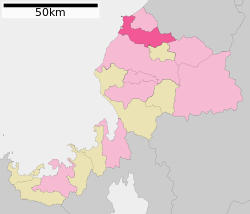Sakai, Fukui
Sakai
坂井市 | |
|---|---|
 Sakai City Hall | |
 Flag  Seal | |
 Location of Sakai in Fukui Prefecture | |
 Sakai | |
| Coordinates: 36°10′1″N 136°13′53.2″E / 36.16694°N 136.231444°ECoordinates: 36°10′1″N 136°13′53.2″E / 36.16694°N 136.231444°E | |
| Country | Japan |
| Region | Chūbu (Hokuriku) |
| Prefecture | Fukui |
| Government | |
| • - Mayor | Norio Sakamoto |
| Area | |
| • Total | 209.67 km2 (80.95 sq mi) |
| Population (May 10, 2018) | |
| • Total | 92,210 |
| • Density | 440/km2 (1,100/sq mi) |
| Time zone | UTC+9 (Japan Standard Time) |
| City symbols | |
| -Tree | Cherry blossom |
| -Flower | Lilium |
| -Bird | Larus canus |
| Phone number | 0776-66-1500 |
| Address | 1-1 Shimoshinjō, Sakai-chō, Sakai-shi, Fukui-ken 919-0592 |
| Website | www |

Sakai (坂井市, Sakai-shi) is a city located in Fukui Prefecture, Japan. As of 10 May 2018, the city had an estimated population of 92,210 in 31,509 households and the population density of 550 persons per km².[1] The total area of the city was 209.67 square kilometres (80.95 sq mi).
Geography[]
Sakai is located in far northern Fukui Prefecture, bordered by the city of Awara and Ishikawa Prefecture to the north and the Sea of Japan to the northeast, The city of Fukui borders the city to the south. The Kuzuryū River flows through the city.
Neighbouring municipalities[]
- Fukui Prefecture
- Ishikawa Prefecture
Climate[]
Sakai has a Humid climate (Köppen Cfa) characterized by warm, wet summers and cold winters with heavy snowfall. The average annual temperature in Sakai is 14.3 °C. The average annual rainfall is 2476 mm with September as the wettest month. The temperatures are highest on average in August, at around 26.9 °C, and lowest in January, at around 2.8 °C.[2]
Demographics[]
Per Japanese census data,[3] the population of Sakai has grown over the past 40 years. The population of the city is the second largest in Fukui Prefecture. The Harue and Maruoka neighborhoods in the southern part of the city, function as commuter towns of the city of Fukui. Accordingly, its population growth rate is much higher than any area in Fukui Prefecture.
| Census Year | Population |
|---|---|
| 1970 | 68,797 |
| 1980 | 75,983 |
| 1990 | 83,372 |
| 2000 | 91,173 |
| 2010 | 91,900 |
History[]
Sakai is part of ancient Echizen Province. The semi-legendary Kofun period Emperor Keitai is said to have come from the area that is now the Maruoka neighbourhood of Sakai. During the Edo period, the area was divided between the holdings of Maruoka Domain, Fukui Domain and tenryō holdings directly under control of the Tokugawa shogunate. Following the Meiji restoration, the area was organised into part of Sakai District in Fukui Prefecture. The epicentre of the 1948 Fukui earthquake was in Maruoka.[4] The towns of Mikuni and Maruoka were created with the establishment of the modern municipalities system on April 1, 1889. The village of Harue was raised to town status on April 3, 1942. The village of Sakai was created on March 1, 1955 by the merger of the villages of Higashi-Jūgō, Hyōgo and Ōseki. It was raised to town status on April 1, 1961. The modern city of Sakai was established on March 20, 2006, from the merger of the former town of Sakai with the towns of Harue, Maruoka and Mikuni. Sakai District was dissolved as a result of this merger.
Government[]
Sakai has a mayor-council form of government with a directly elected mayor and a unicameral city legislature of 26 members.
Education[]
Sakai has 19 public elementary schools and five middle schools operated by the city government, and three public high school operated by the Fukui Prefectural Board of Education. The prefectural also operates one special education school.
High schools[]
- Maruoka Senior High School
- Mikuni Senior High School
- Sakai Senior High School
Transportation[]
Airport[]
- Fukui Airport (No scheduled flight services.)
Railway[]
 JR West - Hokuriku Main Line
JR West - Hokuriku Main Line
 Echizen Railway Mikuni Awara Line
Echizen Railway Mikuni Awara Line
- Taromaru Angelland - Nishiharue Heartpia - Nishinagata Yurinosato - Shimohyogo Kofuku - Ōzeki - (Awara-shi) - Mizui - Mikuni-Jinja - Mikuni - Mikuni-Minato
Highway[]
Local attractions[]
- Echizen-Kaga Kaigan Quasi-National Park
- Tōjinbō, National Scenic Site and Natural Monument
- Maruoka Castle, one of the 100 Famous Castles of Japan
- Maruoka Domain Battery, National Historic Site
- Rokuroseyama Kofun Cluster, National Historic Site
- Technoport Fukui Stadium
- Mikuni Onsen
Notable people[]
- Shigeharu Nakano (from Maruoka) - author and Communist Party politician
- Chosei Komatsu (from Mikuni) – artistic director of the National Symphony Orchestra of Costa Rica
- Ai Takahashi (from Harue) – former leader of Japanese idol group Morning Musume.
- Kazuhiko Masada (from Mikuni) - Japanese professional wrestler and member of Tokyo Gurentai
References[]
- ^ "Sakai City Population Statistics" (in Japanese). Japan: Sakai City. Retrieved 23 May 2018.
- ^ Sakai climate data
- ^ Sakai population statistics
- ^ [1]
External links[]
 Media related to Sakai, Fukui at Wikimedia Commons
Media related to Sakai, Fukui at Wikimedia Commons Sakai travel guide from Wikivoyage
Sakai travel guide from Wikivoyage- Official website (in Japanese)
- Sakai, Fukui
- Cities in Fukui Prefecture
- Populated coastal places in Japan

